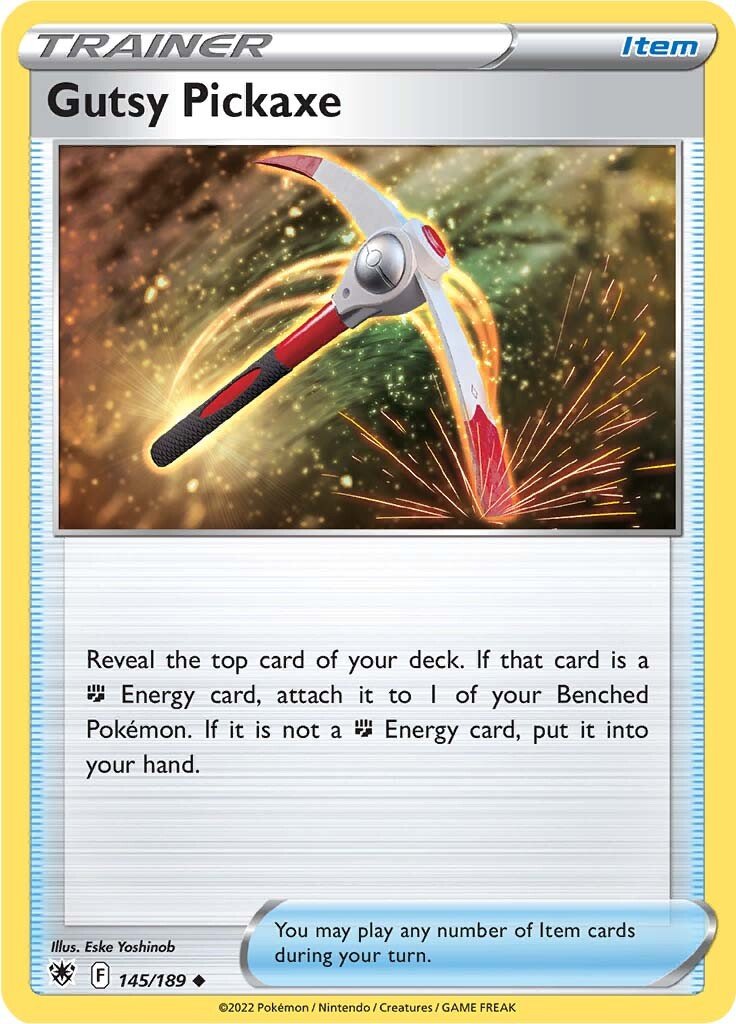Energy and Acceleration
Acceleration
Pokémon
Arceus V BRS 122
Arceus VSTAR BRS 123
Magnezone ASR 107
Archeops SIT 147
Baxcalibur PAL 60
Metang TEF 114
Infernape TWM 33
Supporters
Gardenia’s Vigor ASR 143
Geeta OBF 188
Mela PAR 167
Professor Sada’s Vitality PAR 170
Items and Stadium Cards
Magma Basin BRS 144
Dark Patch ASR 139
Gutsy Pickaxe ASR 145
Mirage Gate LOR 163
Redistribution
Items
Energy Switch SVI 173
Exp. Share SVI 174
Energy Search
Items
Energy Loto ASR 140
Energy Search SVI 172
Earthen Vessel PAR 163
Supporters
Lady LOR 159
Acceleration
Many decks make use of some form of Energy Acceleration—or the use of Trainer cards or Pokémon attacks or abilities to attach more energy cards than the usual one-per-turn. A handful of the more popular acceleration options are listed below.
Pokémon
Arceus V and its Trinity Charge attack work to power up any Pokémon V (including Pokémon VSTAR, Pokémon V-UNION, or Pokémon VMAX) you have in play—whether that’s another Arceus V or VSTAR, or some alternate attacker, Trinity Charge ensures that your deck will have the Energy attachments it needs to keep its strategy flowing.
Decks that include Arceus V tend to include 3-4 copies of the card, but some decks skirt by with just 2 copies.
Arceus VSTAR and its Trinity Nova attack not only do respectable damage, but work to power up any Pokémon V (including Pokémon VSTAR, Pokémon V-UNION, or Pokémon VMAX) you have in play—whether that’s another Arceus V or VSTAR, or some alternate attacker, Trinity Nova ensures that your deck will have the Energy attachments it needs to keep its strategy flowing.
What’s more, Arceus VSTAR’s Starbirth VSTAR Ability gives you a once-per-game option to get any two cards from your deck that you may need. This helps to guarantee you have what you need when you need it—an extremely welcome option for many a deck.
Decks that include Arceus VSTAR tend to include 2-3 copies of the card.
Magnezone offers a way of accelerating basic Metal Energy from your deck by filtering them out of the top 6 cards from your deck. Decks that intend to use Magnezone—a Stage 2 Pokémon—to accelerate Energy in this way will find they need to run a higher-than-typical Energy count in order to consistently hit Energy off of Magnezone’s Giga Magnet ability, which further cripples such a deck’s consistency.
Decks that are looking to use Magnezone to accelerate Energy will include 2-3 copies of Magnezone and 2-3 copies of Magnemite, the Basic Pokémon, plus 3-4 copies of Rare Candy.
Archeops has an extremely powerful Ability in Primal Turbo. Combined with Lugia VSTAR’s Assembly Star VSTAR Power, which can pull two Archeops from the discard into play, Archeops is sure to get out quickly and rapidly power up your Pokémon by searching your deck for 2 Special Energy cards and attaching them to 1 of your Pokémon.
Decks that play Archeops most often play 4 copies of the card in conjunction with some combination of Lugia V and Lugia VSTAR.
Baxcalibur’s Super Cold ability is one commonly referred to as a “Rain Dance” effect in that it allows you to attach as many Water-type Energy cards from your hand as you like to your Pokémon in play. This powerful ability is hampered only by the hit to a deck's consistency brought upon by its being a Stage 2 Pokémon.
Decks that include Baxcalibur tend to include 2-3 copies each of Baxcalibur and Frigibax, the Basic Pokémon, in addition to 4 copies of Rare Candy, to skip evolving into Artibax.
Metang allows you to rapidly flood your Pokémon with Metal Energy by pulling all of the Basic Metal Energy from the top 4 cards of your deck. As the Pokémon you attach to doesn’t have to be a Metal-type Pokémon and doesn’t need to be on the Bench like other Energy-accelerating abilities require, Metang can be an option worth considering even in unexpected places.
Decks that run Metang tend to run 3-4 copies, in addition to 3-4 copies of the Basic Pokémon, Beldum.
Infernape’s biggest strength as an energy accelerator comes from its flexibility. Infernape’s Pyro Dance Ability accelerates both Fighting and Fire Energy from your hand to any of your Pokémon in play. The biggest disadvantage it has is that in order to use it to its fullest potential, a deck making use of Infernape must split its energies between those two types—a split that inevitably becomes an additional hit to consistency after already suffering the hit to consistency that relying on a Stage 2 Pokémon brings.
Decks that include Infernape tend to include 2-3 copies of Infernape and 3-4 copies of Chimchar, the Basic Pokémon, in addition to 4 copies of Rare Candy, to skip evolving into Monferno.
Supporters
Gardenia’s Vigor may draw just two cards, but its secondary effect—attaching up to two Grass Energy cards from your hand to one of your benched Pokémon—means that your Pokémon can be out and attacking faster than they would otherwise. Furthermore, Gardenia’s Vigor allows you to attach those Energy cards after you draw the two cards, making it possible to attach Grass Energy you draw into with its effect.
Decks tend to avoid Gardenia’s Vigor because of its weak draw effect, but decks that are desperate for its acceleration effect tend to use 1-2 copies of the card.
Geeta accelerates two Basic Energy cards from your deck to 1 of your Pokémon in play. However, in exchange for this effect, Geeta makes you unable to attack with any of your Pokémon for the remainder of the turn—a high cost to pay on any turn except, for some decks, your first turn.
Because this card cannot be played by a player going first—even if it can be found with the effect of Lumineon V’s Luminous Sign Ability—Geeta sees limited play.
Mela is a powerful ‘get back in the game’ rebound card that offers a combination of Energy acceleration and draw power to help you rebound after 1 of your Pokémon has been Knocked Out.
In order to make adequate use of Mela, a deck must be built to contain Basic Fire Energy—and many decks simply aren’t able to accommodate it. Decks that do run Mela generally run just 1 copy.
Professor Sada’s Vitality may not draw nearly as many cards as Professor’s Research, but its secondary effect—attaching 1 Energy from your discard pile to up to 2 of your Ancient Pokémon—means that your Pokémon can be out and attacking faster than they would otherwise.
Decks that make use of Professor Sada’s Vitality tend to use 4 copies of the card.
Items and Stadium Cards
Magma Basin works in combination with cards that discard Fire energy from your hand—like Ultra Ball—to attach a Fire Energy from your discard pile to 1 of your Benched Fire-typed Pokémon and at only the cost of 2 damage counters. Magma Basin makes it significantly easier to power up the attacks of many Fire-type Pokémon and can be an important asset in any deck that focuses on a Fire-type main attacker.
Decks that run Magma Basin tend to include 3-4 copies of the card.
Dark Patch is an immediate inclusion for any deck built around a Darkness-type main attacker. Dark Patch not only accelerates energy from the discard pile, but can also serve as a pseudo energy recovery option.
Decks that run Dark Patch tend to include 4 copies of the card.
Gutsy Pickaxe is an Item card that draws you another card, effectively turning your deck into a 56-card deck when you play 4 copies of the card. As an additional benefit, if the card it draws into is a basic Fighting Energy, you are able to attach it to one of your Benched Pokémon—providing a small bit of acceleration.
Decks that can make use of Gutsy Pickaxe tend to run 3-4 copies.
Mirage Gate is the keystone of the Lost Engine. Together with Comfey LOR 79 and Colress’s Experiment, Mirage Gate allows you to search your deck for two Basic Energy cards of different types and to attach them to your Pokémon in any way you like, provided you have successfully put seven cards into the Lost Zone. This can make it easier to power up Pokémon with complex attack costs, like Dragon-type Pokémon.
Only decks focused on interaction with the Lost Zone and the Lost Engine are likely to ever use Mirage Gate. Those decks will run 4 copies of the card. Others will not use it.
Redistribution
Items
Energy Switch offers a quick and simple way to move energy from one Pokémon to another. This can mean powering-up a Pokémon’s attacks more quickly or even taking advantage of benched-based energy acceleration, like Dark Patch, with more ease.
Energy Switch’s biggest disadvantage is that it isn’t able to move Special Energy from one Pokémon to another.
Decks that run Energy Switch tend to include 3-4 copies.
Exp. Share can be a handy tool for decks that are sensitive to losing energy when one of its Pokémon is knocked out, like decks without energy acceleration options or decks that are especially reliant on manually attaching a single Basic Energy card each turn.
Decks don’t often run Exp. Share, but those that do tend to run 2-3 copies.
Energy Search
Items
Other Prints: GRI 122
Energy Loto may not search your whole deck for an Energy card like Energy Search, but it does give you a way to dig for any Energy card, including a Special Energy card, without having to use your Supporter for the turn to do so.
If your deck isn’t running Special Energy—and especially if it isn’t reliant on Special Energy, it’s like that Energy Search is a better option. However, if your deck needs its Special Energy, Energy Loto may be a good inclusion. Decks that run Energy Loto tend to run 2-3 copies of the card.
Energy Search is a simple Item card—find a Basic Energy card and put it into your hand. This simple effect is most powerful when paired with cards that can search for Energy Search directly, like Irida or Arven.
Decks that run Energy Search tend to run 1-2 copies. However, decks that would run Energy Search tend to favor Earthen Vessel instead.
Earthen Vessel, similar to Energy Search, is a simple Item card that finds a pair of Basic Energy cards and puts them into your hand in exchange for discarding a card from your hand. This simple effect is most powerful when paired with cards that can search for Energy Search directly, like Irida or Arven, or when played in high counts. Earthen Vessel’s discarding cost often works toward a deck’s advantage, especially when decks favor discarding cards like Basic Energy to later attach them via some form of Energy acceleration, like Professor Sada’s Vitality.
Decks that run Earthen Vessel tend to run 2-4 copies.
Supporters
Lady is a simple Supporter card—find up to four basic energy cards from your deck and put them into your hand. Most decks will prefer other options, especially Item-based options like Energy Search. However, decks that are able to flood the board with Energy attachment effects may find the heavy energy search effect of Lady helpful.
Most decks will not use Lady in any capacity. Those that find it useful will likely run just one to two copies.





